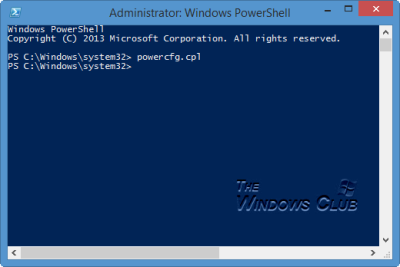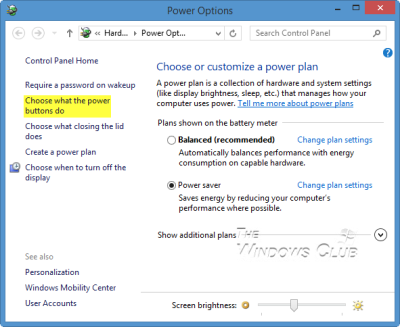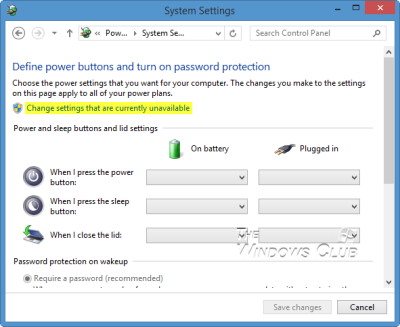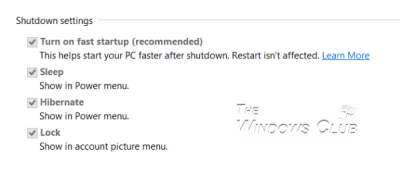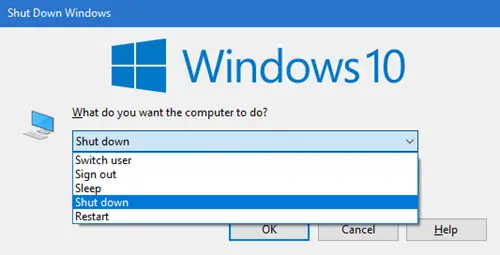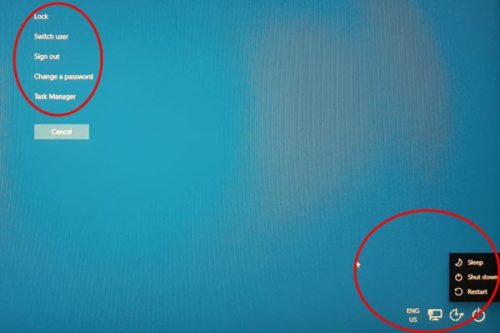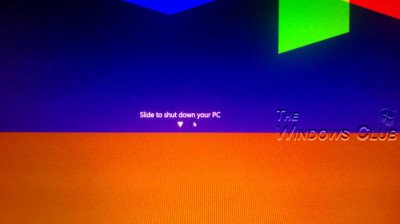In this post, we will show you the different ways to Shutdown, Restart, Sleep, Hibernate Windows 11 or Windows 10 computer. While there are many ways you can shut down Windows 8, users had to follow a tedious procedure if they wanted to add Shutdown and Restart to the WinX Power-user Menu. Microsoft had listened to feedback and made things easy in the Windows 8.1 Update and Windows 10. Now one can simply open the WinX or Power User Menu, by moving your cursor to the bottom left corner and right-clicking.
Windows 11 is a new iteration of Microsoft Windows. Even though it is not completely different from Windows 10, but there are some changes in the GUI that may confuse you a bit initially. In this guide, we are going to see how to Shutdown, Restart, Sign, Sleep, Hibernate or Switch User in Windows 11.
How to Shutdown, Restart, Sleep, Hibernate, Lock Windows 11/10
You can Shutdown, Restart, Sleep, Hibernate, Switch User, Lock, Log off Windows 11/10 using the following methods:
- Via Start Menu
- Via WinX Menu
- Create Desktop Shortcut
- Set Keyboard shortcuts
- Using the Context Menu
- Using Command Prompt or Run
- Using PowerShell
- Using Alt+F4
- From the Lock Screen
- Using Cortana
- Shut down Windows 10 using the Power button
- Via System Tray
- Use free tools to schedule shutdowns, restarts, etc
- By defining laptop lid actions
- Slide To Shut Down on Windows 10 tablets.
Let us see them one by one.
1] Via Start Menu
If you are acquainted with the previous generation of Windows then you may already know that one can easily turn the system off from the Power button. You can just click on the Start Menu or hit the Start button that’s on your Keyboard. However, by default, the Start Menu button is at the center in Windows 11, whereas, in the previous version of Windows it’s on the left. After opening the Start Menu, click on the Power button, and then from there, you can Shutdown or Restart.
Windows 11
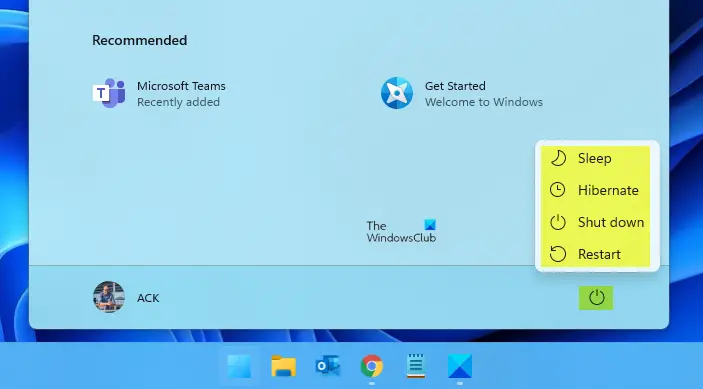
To Shutdown, Restart, Sign, Sleep, Hibernate Windows 11 using the Start Menu:
- Click on the Start button
- The Start Menu will open
- Click on the Power button that you see on its bottom right side
- A flyout will open
- Select Shutdown, Restart, Sign, Sleep or Hibernate.
Windows 10
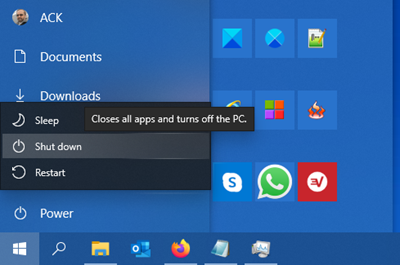
Click on the Start button on your Windows 10 taskbar and the Start Menu will fly out. Click on Power and you will see the power options available to you.
Using this method you can Shut down, Restart, Sleep, Hibernate, Lock your PC.
If you don’t see some options you can add them in Windows 11 or Windows 10. To add the Hibernate, Lock and Sleep options here open Windows PowerShell (Admin), type powercfg.cpl and hit Enter to open Power Options.
In the Power Options applet of the Windows Control Panel, on the left side, you will see Choose what the power buttons do. Click on it.
Under the Power System Settings, click on Change settings that are currently unavailable and scroll down.
You will see the following options being offered. Select Sleep and Hibernate.
You will now see the Hibernate and Sleep option also being made available in the Windows WinX Power User Menu.
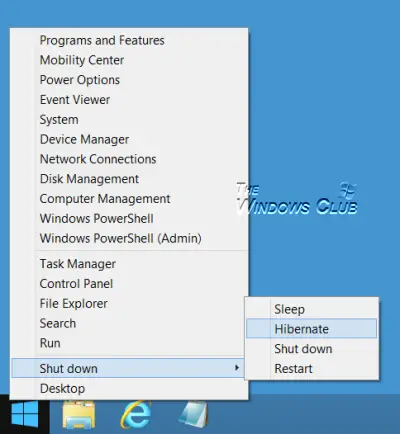
This is the most used way to shut down or restart your PC.
2] Via WinX Menu
Windows 11
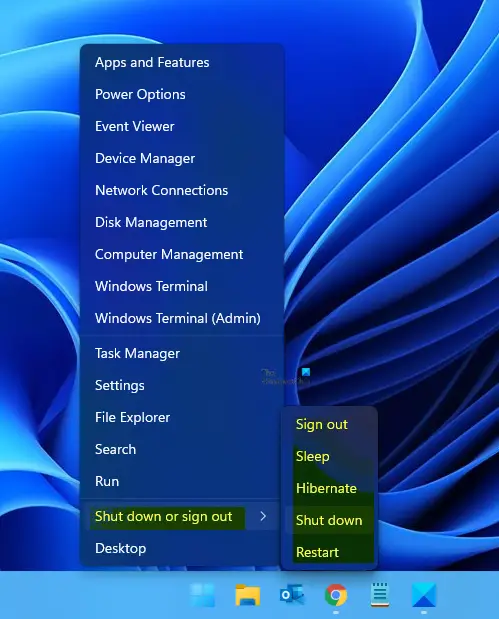
To Shutdown, Restart, Sign, Sleep, Hibernate Windows 11 using the WinX Power Menu:
- Right-click on the Start button
- The WinX Power Menu will open
- Click on Shut down or sign out
- A flyout will open
- Select Shutdown, Restart, Sign, Sleep or Hibernate.
Win+X is nothing but a shortcut to trigger right-click of the Start Menu. So, you can either right-click on the Start Menu or hit Win + X. Then go to Shut down or sign out, from there you can select Shutdown, Restart, or Sign out.
TIP: You can Restart Windows 11 using Keyboard – Press Win+X to open Power User menu, then press U key and then press R key. Similarly use S, L, H, etc, for other options instead of R.
Windows 10

If you right-click on the Start button, the WinX Power Menu will pop out.
Click on Shut down or sight out and you will see the options that are available to you.
3] Create Desktop Shortcut
You can simply create a shortcut to shut down or restart, on your Windows PC and give it a nice icon.
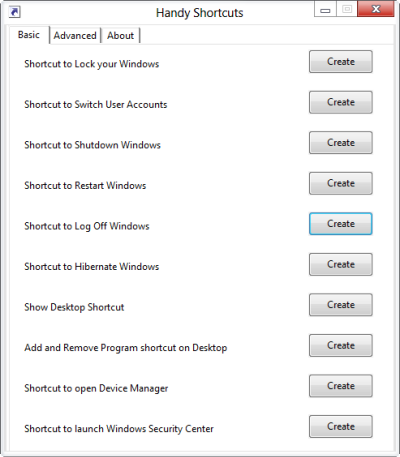
To create Shutdown, Restart, etc, shortcuts you may also use our freeware portable tool called Handy Shortcuts, which lets you create such shortcuts in a click – along with a custom icon!
4] Set Keyboard shortcut
You can shut down or restart your Windows PC using a hotkey.
To do so, right-click on the shortcuts you have created (above) and select Properties. Here in the Shortcut Key space, click the hotkey you want to be assigned to the action. This will automatically appear in the field.
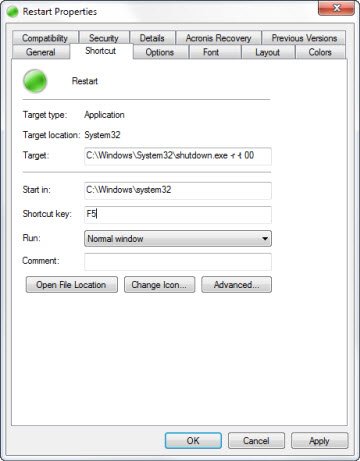
Click Apply/OK.
5] Using the Context Menu
You can edit the Registry, to add these Power options to your desktop right-click context menu.
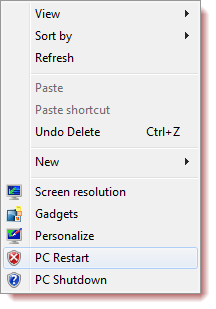
But rather than touching your Windows Registry, we recommend that you use our portable freeware app Ultimate Windows Tweaker. You will see the setting under Context Menu > Desktop Context Menu. You can also add Shut down or restart using our other tool Right Click Extender.
6] Using Command Prompt or Run
Geeks may be aware of using this way of shutting down or restarting the Windows operating system, using the shutdown options in a command prompt. For instance, if you happen to have your command prompt open, to shut down your PC type:
shutdown / s
To restart your PC type:
shutdown / r
and then hit Enter.
You can shut down Windows 11/10/8/7, using Run. Open Run, type the following and hit Enter:
shutdown -s -t 0
If the computer is not able to shutdown or restart because it’s being blocked, then type the following on the command prompt, followed by pressing the Enter key
Shutdown –r –f
to force reboot
Shutdown –r –f
to force shutdown
To perform a Timed Force Restart or Shutdown, type in Shutdown –r –f –t 01 or Shutdown –s –f –t 01.
The last parameter is the time after which the shutdown or restart commences. It gives you enough time to save work.
To put your PC to Sleep use the following command.
rundll32.exe powrprof.dll,SetSuspendState 0,1,0
You can also use these commands to create a desktop or a keyboard shortcut.
7] Using PowerShell
You can shut down or restart Windows using these PowerShell commands:
Stop-Computer
Restart-Computer
Type them in a PowerShell prompt and hit Enter.
8] Using Alt+F4
While on your desktop, click on Alt+F4 to bring up the shutdown dialog box. This box will give you quick access to Shutdown, Restart, Sleep, Switch user and Sign out from your Windows computer. You can also create a shortcut to open Windows Shut down Dialog Box.
9] From the Lock Screen
Press Ctrl+Alt+Del, and on the screen which appears, from the button which appears in the bottom right side, you will see the options to Shutdown, Restart, and Sleep.
10] Using Cortana
You can make use of Cortana to Restart, Log Off, Hibernate, Shutdown, Sleep, Lock your Windows 10 computer.
11] Shut down PC using the Power button
You can press the power button of your desktop or laptop to shut down the machine.
12] Via System Tray
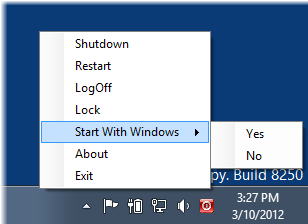
Another way would be to use our freeware tool called HotShut. This light-weight portable tool, will sit quietly in your taskbar notification area and give you options to shutdown, restart lock and log off. You can also set it to start with Windows.
13] Use free tools to schedule shutdowns, restarts, etc
You can use free tools to Auto Shutdown, Restart Windows 10 computer at fixed times. You can schedule Shutdown or Restarts in Windows 10 using the Task Scheduler too!
14] By defining laptop lid actions
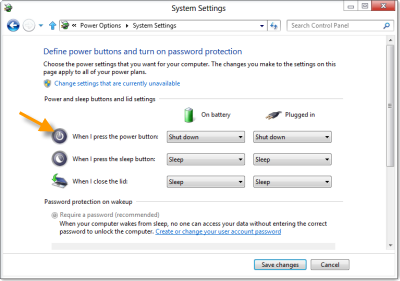
You can via Power Options in the Control Panel, define what the Power button will do when you press it, or what should happen when you close the lid of your laptop.
15] Slide To Shut Down on Windows 10 tablets
Microsoft has provided for an even easier way to shut down Windows 10/8.1 tablets or touch devices. The process involves SlideToShutDown.exe which is situated in the System32 folder. This Slide To Shut Down feature can be used with a touch device or even with a mouse.
So if it has become difficult to shut down or restart the computer using the button, you can use any of these methods to restart or shutdown the computer. All these are helpful if the computer is not able to shutdown.
Is restarting your PC bad or good?
Restarting your PC is not bad at all. In fact, there are some problems that can be easily fixed by restarting your system. However, you should not do it frequently, for example, multiple restarts in a day are not needed. The reason being, when you turn your computer off, your HDD spins down, and then when you turn it back on, it starts spinning again. This can have an adverse effect on your Hard Drive. Unless the system requires it, I usually restart my PC once a week.
Related links that are sure to interest you:
